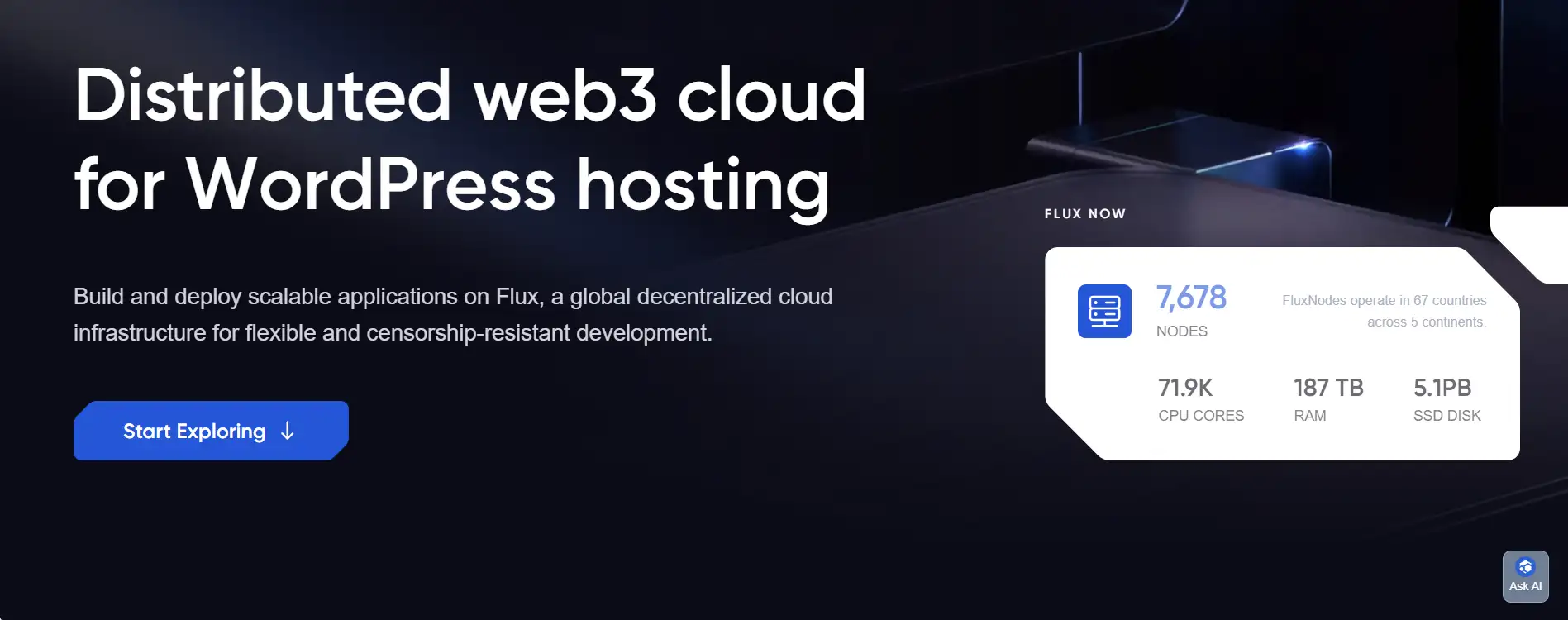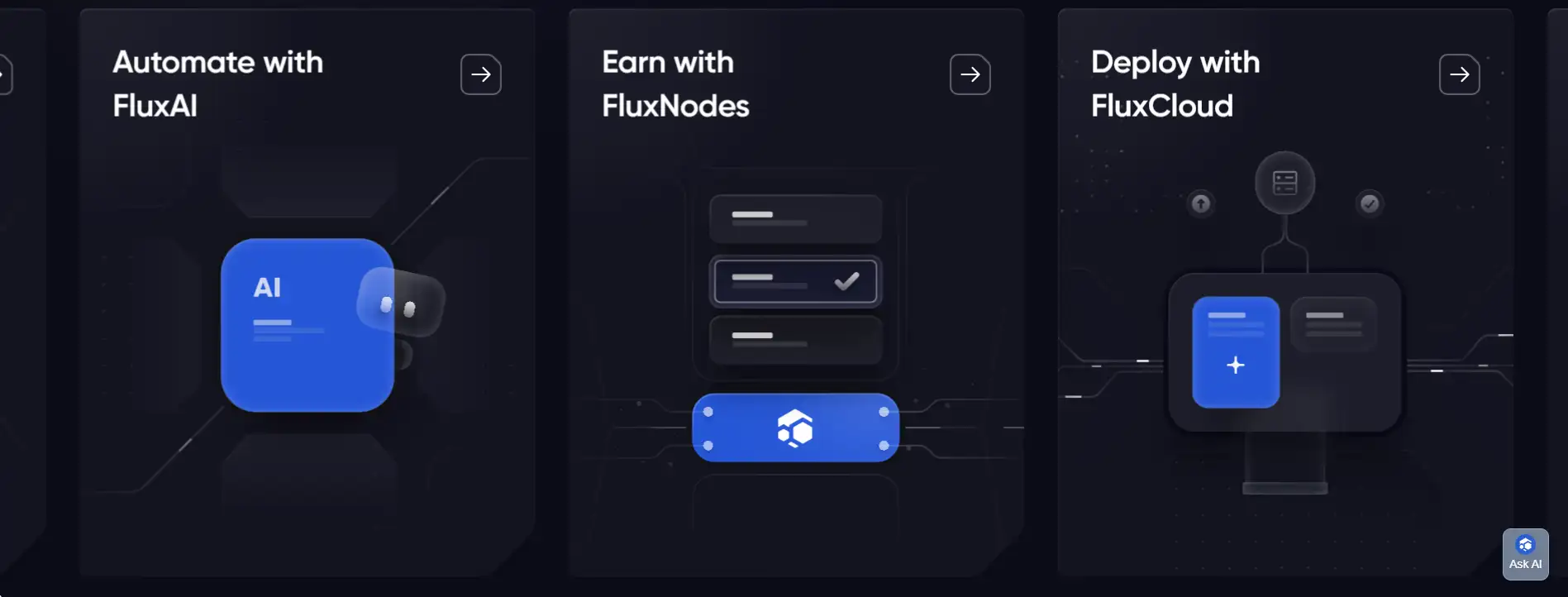About Flux
Flux is a globally distributed, user-powered decentralized Web3 cloud infrastructure designed to support scalable, censorship-resistant application deployment. Operating across 67 countries with over 8,000 nodes and a robust compute backbone, Flux provides developers and enterprises with an alternative to centralized cloud providers like AWS, offering unmatched flexibility and autonomy.
With an architecture built for resilience and scalability, Flux allows users to deploy dApps, smart contracts, and backend services on a globally distributed network of FluxNodes. From dedicated compute resources to Web3 services like node operations and blockchain mining, Flux enables a high-performance ecosystem that is both secure and decentralized—backed by a community-driven model and supported by cutting-edge infrastructure like Arcane OS and the latest Proof of Useful Work (PoUW v2) consensus mechanism.
Flux is a powerful decentralized cloud platform built to disrupt traditional Web2 infrastructure by offering a globally distributed network of community-operated nodes. Unlike centralized providers such as AWS, Microsoft Azure, or Google Cloud, Flux empowers developers with true ownership and flexibility over their deployments, ensuring censorship resistance and greater reliability across the network.
At its core, Flux consists of over 8,000 operational nodes spanning 67 countries across five continents. These nodes offer a combined capacity of over 66,000 CPU cores, 200 TB of RAM, and 5.1 PB of SSD storage. The compute resources are rented out in a permissionless manner, enabling developers and enterprises to tap into dedicated, high-availability infrastructure for running full-stack applications, smart contracts, game servers, databases, websites, and more—all without relying on centralized intermediaries.
One of the cornerstones of the Flux ecosystem is the recent deployment of Proof of Useful Work v2 (PoUW v2), which delivers faster block times, increased finality, and steady reward emissions. This innovation allows for more efficient application registration and reduces latency, giving developers a smoother, more responsive experience while simultaneously increasing the economic viability for node operators.
Flux also introduces Arcane OS, a secure operating system for FluxCloud deployments. Arcane OS allocates and isolates disk space cryptographically to maintain a tamper-resistant environment, securing every layer of application logic and infrastructure. This innovation is key for projects requiring heightened levels of trust and performance, especially in financial, enterprise, or AI workloads.
With complementary offerings like FluxAI, FluxEdge, and a decentralized Marketplace, the ecosystem is rapidly expanding its utility across verticals including AI, IoT, decentralized finance, and edge computing. The platform's community-first approach and open governance make it a compelling choice for developers seeking to build in a fully decentralized, scalable, and globally resilient environment.
In contrast to traditional and emerging platforms such as Amazon Web Services (AWS), Akash Network, or Filebase, Flux stands apart with its focus on full decentralization, community-operated infrastructure, and Web3-native compute architecture.
Flux provides a robust suite of cloud computing features and decentralized services that give developers, enterprises, and communities the tools they need to operate independently:
- Global Node Network: More than 8,000 nodes across 67 countries delivering low-latency, high-availability compute on demand.
- Proof of Useful Work (PoUW v2): Shorter block times and consistent emissions enable faster finality and optimized reward structures.
- Decentralized Compute Power: Users can rent dedicated CPU, RAM, and SSD resources from the network to run Web3-native or traditional workloads.
- Arcane OS Security: Cryptographically allocates disk space for robust, tamper-proof on-chain application deployment.
- FluxCloud & FluxEdge: Offers a decentralized environment for building and deploying full-stack, edge-optimized applications.
- Self-Sovereign Infrastructure: Unlike centralized platforms, Flux empowers users to control their data, compute, and deployment lifecycle.
- Developer-Friendly Tools: Includes managed services, a WordPress hosting solution, marketplace access, and integrations with major DevOps workflows.
- Eco-Friendly Architecture: Nodes are operated by individuals using underutilized hardware, promoting sustainability through green computing principles.
Flux makes it easy to begin deploying scalable Web3 applications with decentralized infrastructure:
- Step 1 – Visit the Official Website: Go to runonflux.com and click on “Start Exploring” or “Flux Now” to enter the dashboard.
- Step 2 – Explore FluxCloud: Review the platform’s available compute capacity, features, and current marketplace applications to understand your deployment options.
- Step 3 – Create a Flux Wallet: Set up a Flux-compatible wallet using their provided tools or third-party integrations to manage assets and application permissions.
- Step 4 – Select and Deploy Services: Choose from a range of services such as Web hosting, node operation, or GPU compute. You can deploy Dockerized apps via the Flux UI or CLI.
- Step 5 – Leverage Arcane OS: For secure and high-performance deployment, utilize Arcane OS for disk-level cryptographic integrity and protection.
- Step 6 – Monitor and Manage: Use the Flux dashboard to manage resource usage, rewards, node performance, and service uptime across your deployments.
- Step 7 – Join the Ecosystem: Contribute as a node operator, developer, or enterprise client. Access developer docs, GitHub, and the vibrant community on Discord.
Flux FAQ
PoUW v2 significantly improves Flux’s network performance by reducing block production times from 2 minutes to a faster cadence, enhancing transaction finality and application responsiveness. This upgrade enables more efficient app registration and deployment, ensures steady emissions for node rewards, and increases the network’s overall computational throughput. For both users and node operators, PoUW v2 brings greater predictability and uptime across the decentralized cloud infrastructure.
Arcane OS is a purpose-built, cryptographically enforced operating system that ensures each Flux deployment is isolated and tamper-resistant. It cryptographically allocates disk space to apps, preventing unauthorized access and enhancing on-chain security. This is critical for decentralized applications requiring reliable, secure environments, such as those in DeFi, AI, and edge computing.
Unlike centralized services like AWS or GCP, Flux offers a fully decentralized Web3 cloud infrastructure powered by thousands of independent node operators. Users maintain full control of their data and compute, while avoiding vendor lock-in and censorship risks. Flux supports global scalability, low-latency performance, and community governance—key features not typically found in traditional cloud models.
Yes. Flux supports native Docker containers, allowing developers to deploy existing applications with minimal modification. By uploading the Docker image and defining a simple configuration file, apps can be run seamlessly across the Flux network. This compatibility makes it easy to migrate services and reduce development friction for Web3 and Web2 projects alike.
Running a FluxNode offers participants the opportunity to earn rewards through Proof of Useful Work while contributing compute resources to the network. Node operators help power decentralized apps globally and benefit from stable emissions, performance-based incentives, and a role in shaping the future of decentralized cloud services. The community-driven model also provides Flux operators with access to support, governance participation, and long-term ecosystem value.
You Might Also Like












